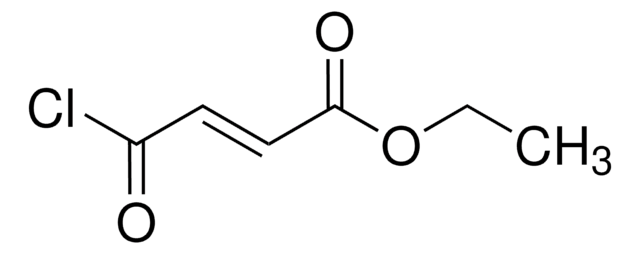338303
Chloroethane solution
2.0 M in tert-butyl methyl ether, anhydrous
Sinonimo/i:
Ethyl chloride
About This Item
Prodotti consigliati
Grado
anhydrous
Livello qualitativo
Densità del vapore
2.22 (vs air)
Tensione di vapore
20.03 psi ( 55 °C)
5.98 psi ( 20 °C)
Stato
liquid
Temp. autoaccensione
966 °F
Concentrazione
2.0 M in tert-butyl methyl ether
Impurezze
<0.005% water
Densità
0.775 g/mL at 25 °C
Gruppo funzionale
alkyl halide
chloro
Temperatura di conservazione
2-8°C
Stringa SMILE
CCCl
InChI
1S/C2H5Cl/c1-2-3/h2H2,1H3
HRYZWHHZPQKTII-UHFFFAOYSA-N
Cerchi prodotti simili? Visita Guida al confronto tra prodotti
Descrizione generale
Applicazioni
- Green solvent in biomaterial extraction: Research highlights the use of Chloroethane as an effective solvent for extracting lignin-containing nanocellulose fibrils from date palm waste, emphasizing its potential in enhancing the sustainability of biomaterial processing (Raza et al., 2024).
Confezionamento
Compatible with the following:
- Aldrich® Sure/Pac™ station for liquefied gases Z566446
- PTFE Sealing tape Z104388 or Z221880
- Straight septum-inlet adapter Z118141 with septa Z565687 or Z565695
Note legali
Adattatore in ingresso con setto
Comunemente ordinati con questo prodotto
Raccomandato
Avvertenze
Danger
Indicazioni di pericolo
Consigli di prudenza
Classi di pericolo
Carc. 2 - Flam. Liq. 2 - Repr. 1B - Skin Irrit. 2
Codice della classe di stoccaggio
3 - Flammable liquids
Classe di pericolosità dell'acqua (WGK)
WGK 2
Punto d’infiammabilità (°F)
-29.2 °F - closed cup
Punto d’infiammabilità (°C)
-34 °C - closed cup
Scegli una delle versioni più recenti:
Possiedi già questo prodotto?
I documenti relativi ai prodotti acquistati recentemente sono disponibili nell’Archivio dei documenti.
Il team dei nostri ricercatori vanta grande esperienza in tutte le aree della ricerca quali Life Science, scienza dei materiali, sintesi chimica, cromatografia, discipline analitiche, ecc..
Contatta l'Assistenza Tecnica.









